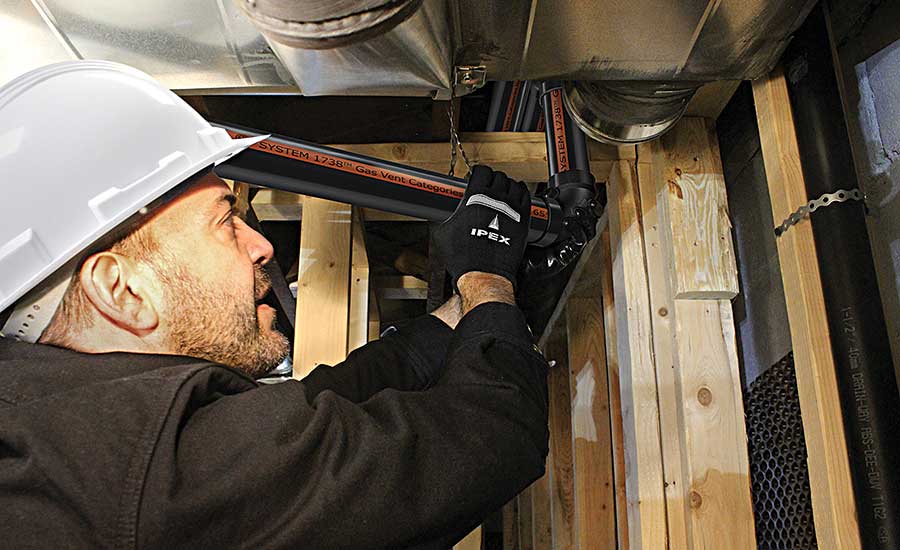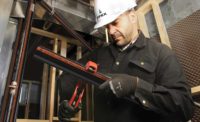Homeowners are exposed to the possibility of a life safety hazard every day, and their safety is in your hands.
Historically, the plumbing and HVAC industry has not nationally regulated the use of plumbing pipes and accessories used for thermoplastic flue gas venting (FGV) installations. Currently, the use of plumbing Schedule 40 solid wall or foam core drain, waste and vent (DWV) pipe and fittings are allowed if they are referenced as options in the appliance installation instructions.
These systems do not meet the UL 1738 safety standard for venting one of the most dangerous and silent killers — carbon monoxide. Take the time to read this article, familiarize yourself with the safety facts and help families in your community remain safe.
The code change and better venting option
The use of plastic venting systems on gas-fired water heaters, furnaces and boilers has undergone a significant change. The NFPA 54-18 and IFGC-18 fuel gas codes now recognize the UL 1738 venting standard across the United States.
FGV systems are used to safely remove lethal combustion gases, namely carbon monoxide, generated by gas-burning appliances from homes and businesses to the outdoors. Because venting systems provide this essential safety feature, they must be built, installed and maintained to the appropriate standard for this specialized function. The UL 1738 standard consists of stringent requirements for nonmetallic venting systems intended for venting categories II and IV gas-burning appliances.
The safety concern today is in the use of plumbing DWV products in FGV applications. These products were never intended to be used in FGV applications, but they have been chosen because they are often the least expensive materials available. Several manufacturers of these products have stated time and again that these products are not suitable for FGV. These products do not meet the key performance requirements nor most of the material requirements of UL 1738.
Simply put, plumbing DWV products are not designed to meet the life safety standards of FGV applications.

ASTM standards vs. UL 1738
Currently, the use of thermoplastic plumbing products are referenced in the ANSI Z21 appliance standards as being suitable materials in FGV applications; provided that they comply with specific ASTM standards and are certified by the appliance manufacturer as an approved option for venting.
However, these ASTM standards are for fluid handling applications only. For example, ASTM D1785-15 is a standard for pressure-rated Schedule 40, 80 and 120 PVC pipe intended for use with distribution of pressurized liquids only. In fact, the 2015 standard states: “This standard specifies dimensional, performance and test requirements for plumbing and fluid handling applications only. It does not include provisions for the use of these products for venting of combustion gases. UL 1738 is a standard that does include specific testing and marking requirements for flue gas venting products, including PVC.”
UL 1738 standard requirements
For peace of mind, choose UL 1738-certified products that include specific testing and marking requirements for FGV applications. In addition, part of the certification process includes formal approval of all installation instructions, and special marking and labeling requirements for pipe, fittings and cement. It is important to note that different manufacturers have different joint systems and/or cements. UL 1738 stipulates: Do not mix pipe, fittings or joining methods from different manufacturers.
Meeting the UL 1738 standard ensures that the venting system is suitable and safe for FGV applications intended to vent categories II and IV gas-burning appliances.
Why specify UL 1738?
Saving lives: FGV is a life safety application and UL 1738 is a specific standard that qualifies the use of metallic or nonmetallic products specifically manufactured for FGV applications.
The use of correct building materials for any job is essential. For a flue gas venting installation, it mitigates risk because it is a matter of life or death. It is particularly important that the appropriate FGV piping system be used to ensure poisonous gases, such as carbon monoxide, are properly exhausted.
In Canada, the gas code adopted the ULC S636 standard for nonmetallic FGV systems. The code adaption of ULC S636 certification was prompted by the Canadian safety authorities due to identified failures in a number of existing plastic flue gas venting systems. This code change has made a positive impact on the safety of flue gas venting in Canadian homes and businesses. Since 2007, inspectors have been able to confidently verify, in nonmetallic systems, that the critical standards for life safety and installation have been met.

The UL 1738 Standard stipulates: Do not mix pipe, fittings, solvents or joining methods from different manufacturers.
Deadly results
The U.S. Environmental Protection Agency website states: “Carbon monoxide (CO) can cause harmful health effects by reducing oxygen delivery to the body’s organs (such as the heart and brain) and tissues. At extremely high levels, CO can cause death.” Failed venting of gases from burning fossil fuels can result in raised levels of CO and tragedy.
In the years from 1999 to 2010, data shows unintentional carbon monoxide poisoning caused 5,149 deaths in the United States. That’s an average of 430 deaths per year. Poor venting may contribute to these statistics. For added peace of mind, when it comes to the safety of families and workers, it makes sense to use a FGV piping system that meets and is certified to the UL 1738 safety standard.
It’s time for a UL 1738-certified flue gas venting system to be installed that safeguards against the dangers of carbon monoxide.



